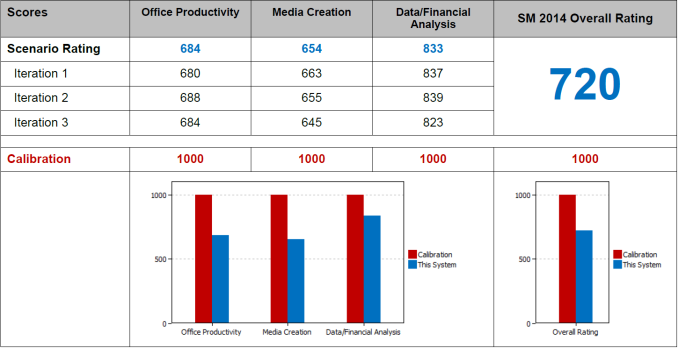The Intel Compute Stick (Core m3-6Y30) Review
by Ganesh T S on June 27, 2016 8:00 AM EST- Posted in
- Systems
- Intel
- Core M
- Skylake
- HDMI Stick
- Compute Stick
Performance Metrics - I
The Intel Core m3-6Y30 Compute Stick was evaluated using our standard test suite for low power desktops / industrial PCs. Not all benchmarks were processed on all the machines due to updates in our testing procedures. Therefore, the list of PCs in each graph might not be the same. In the first section, we will be looking at SYSmark 2014, as well as some of the Futuremark benchmarks.
BAPCo SYSmark 2014
BAPCo's SYSmark 2014 is an application-based benchmark that uses real-world applications to replay usage patterns of business users in the areas of office productivity, media creation and data/financial analysis. Scores are meant to be compared against a reference desktop (HP ProDesk 600 G1 with a Core i3-4130, 4GB RAM and a 500GB hard drive) that scores 1000 in each of the scenarios. A score of, say, 2000, would imply that the system under test is twice as fast as the reference system.
Since SYSmark 2014 was not processed on any of of the PCs in our comparison list, we present the scores obtained in the three iterations of the benchmark above. Obviously, a 7.5W TDP Skylake Core M is no match for a 54W Haswell Core i3. However, it still manages to delivery more than 70% of its performance for business workloads.
Futuremark PCMark 8
PCMark 8 provides various usage scenarios (home, creative and work) and offers ways to benchmark both baseline (CPU-only) as well as OpenCL accelerated (CPU + GPU) performance. We benchmarked select PCs for the OpenCL accelerated performance in all three usage scenarios. These scores are heavily influenced by the CPU in the system. Most of the PCs in our comparison list are equipped with anaemic Atom processors, and the Core m3-6Y30 manages to easily better them in performance despite the form factor limitation.



Miscellaneous Futuremark Benchmarks





3D Rendering - CINEBENCH R15
We have moved on from R11.5 to R15 for 3D rendering evaluation. CINEBENCH R15 provides three benchmark modes - OpenGL, single threaded and multi-threaded. Evaluation of select PCs in all three modes provided us the following results.














105 Comments
View All Comments
Vaz - Tuesday, June 28, 2016 - link
Product photography seems to have hit rock bottom in anandtech reviews.tamalero - Tuesday, June 28, 2016 - link
The cheer size of the power block kinda makes the stick size useless, doesnt it?xodusgenesis - Tuesday, June 28, 2016 - link
Can this handle software decode of H.265? Or does it stress the CPU too much?ganeshts - Tuesday, June 28, 2016 - link
There is hybrid decoding for HEVC 8b - I expect it will work ok for 24p content, even 4K.However, 4Kp60 or HEVC 10b will be a no-go.
Kinematics - Wednesday, June 29, 2016 - link
What about 10-bit h264?It's what's most disappointing in all this small form-factor reviews: At what point is this product *not* going to be useful to you? And all it ever does is cover stuff that I know already is going to work fine. Since I know that 10-bit won't be hardware accelerated (whereas everything that's tested is), it's impossible to even guess at how it compares in areas that you actually need a reviewer to look at.
DonMiguel85 - Tuesday, June 28, 2016 - link
I'm still waiting for that GTX 960 reviewnfriedly - Tuesday, June 28, 2016 - link
I have one of these and one of the m5 versions and I pretty much agree with Anandtech's conclusions. They're the first compute stick that feel "fast enough" for basic office/browsing/htpc tasks. But they're definitely a bit on the expensive side.From what I've seen elsewhere and my personal experience the m5 version is a little faster for bursty workloads, but about on par with the m3 for anything sustained. The graphics might be a bit more powerful, though. Probably not worth the price difference.
Also, on a different topic, Anandtech seriously needs to put some improvements into the commenting system. I had to get to page 4 just to find a single comment about the article... A way to collapse comment threads would probably be good enough, although voting or some kind of moderation might be even better.
lhorror - Wednesday, June 29, 2016 - link
core m3 version on video - https://www.youtube.com/watch?v=AWcULkwryH4piasabird - Wednesday, June 29, 2016 - link
I would like to see comparison of this to something like an STX system where you can use normal DDR4 Ram and a standard CPU, with an M.2 SSD drive, and also an ITX system. All this to determine if it is worth it and also what are the advantages to having a larger drive and more RAM.grand_puba - Friday, July 1, 2016 - link
This website is going from bad to worse. There are few reviews and at least half of them are about cases and shit like that. I am going to remove you from my bookmarks.